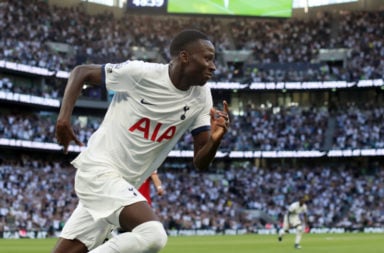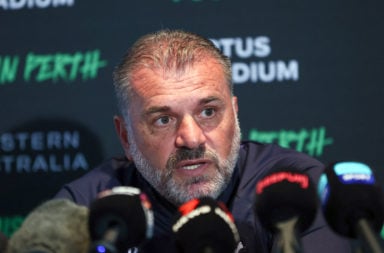Nine years ago, Tottenham had finally announced that Gareth Bale had completed a move away from the club as he joined Spanish giants Real Madrid for a world-record fee at the time of £85.3m (BBC).
Despite Bale’s departure being announced at the final stages of the window, Tottenham were expecting the Welshman’s move away from the club, along with the lucrative fee that partnered his sale.
As such, Spurs confidently spent big in the summer of 2013 as they looked to recycle the fee from Bale into improving the overall squad.
Tottenham brought seven players in the summer window: Paulinho from Corinthians was the first signing completed on July the 6th costing a fee of around £17.8 million, next to be announced was former FC Twente player, Nacer Chaldi who cost a further £7.3 million (TransferMarkt).
Heading into August, Spurs started to buy thick and fast with the marquee signing being Roberto Soldado who was signed from Valencia off the back of his impressive 24 goals in La Liga over the course of the 2012/13 season; Roberto cost the club £27 million (TransferMarkt).
Tottenham weren’t satisfied with Paulinho being the only midfield signing of the window as Etienne Capoue was signed for £9.9 million from French side Toulouse (TransferMarkt).
In typical Tottenham style, there were numerous deals left until the closing stages of the window as Erik Lamela was announced as the joint-most-expensive deal out of the seven as Roma charged £27 million for the 21-year-old Argentine winger (TransferMarkt).
The entrance door to Hotspur Way had barely shut as defender Chiriches was signed for £8.6 million along with Spurs’ final signing of their busy window, Christian Eriksen, who was purchased for around £12.7 million from Dutch side Ajax, concluding Tottenham’s summer spending at over £110 million (TransferMarkt).
At the time, all these deals were incredibly exciting for Spurs fans and contributed to a great deal of anticipation to see all seven in action, contrasted by a slight feeling of worry as fans knew that Gareth Bale will no longer be at White Hart Lane.
With hindsight, it’s now easy to realise that the expectations and hope for the majority of these new signings was too high as all seven have now departed the club. Soldado, for example, was infamous for his easy misses and lack of goals scored in Lilywhite colours.
There were two players that stuck with the club for the long-term, however, as Eriksen proved to be the main success from this shopping spree, with the Dane spearheading the midfield under Argentine Mauricio Pochettino.
Erik Lamela never hit the heights expected of him when he joined but the winger did stay for eight years at the club and shone on rare occasions.
Despite Eriksen and Lamela’s success at the club since joining in 2013, it’s widely agreed that the transfer window was one of Tottenham’s worst, with the bulk of the players purchased leaving only a season or two after.
Most also failed to recoup their large fees. All the signings were completed under the watchful eye of Daniel Levy and sporting director, Franco Baldini, who did his best to try and rebuild a squad that had become heavily reliant on a magical Gareth Bale. It’s safe to say that Baldini’s efforts fell short of the mark.
Which brings us onto the topic of this season’s transfer window where Tottenham have similarly spent large amounts in the window, reaching the £100 million mark (TransferMarkt).
And, like in 2013 the deals have mainly been worked on by a director of football, this time it’s Fabio Paratici who aims to reinforce Antonio Conte’s Tottenham squad, rather than rebuild it.
The fact that this summer’s aim is to improve and deepen the squad is what differentiates it from the summer of 2013 which had a heavier reliance on rebuilding the team entirely. Many of the players entering the club nine years ago were expected to adapt instantly to Premier League football and take up a starting role in the side.
It seems that lessons have been learnt from the summer of 2013 as Paratici is, unlike Baldini, shopping in the English market with Premier League-proven players such as Richarlison and Bissouma.
The lack of signings from England is perhaps what put the writing on the wall for Baldini’s signings in 2013 as not one player had ever experienced a minute of Premier League football before their Tottenham debuts.
Just to further add to the culture shock of these players, they had all joined from six different leagues with many speaking different languages too, contributing to an incredibly difficult settling-in period at the club.
Another reason why it may be safe to say that Spurs fans have cause for excitement this summer, and shouldn’t be haunted by the experience of the Gareth Bale window, is that the average age of players that Spurs have purchased (27 years old) is significantly higher than the average age of player brought in 2013 (24 years old).
The mix of experience and youth not only minimises risk but it also means Conte has a higher standard of players to fight in the here-and-now, rather than building for the future.
A player such as Ivan Perisic is a prime example of this. The Croatian is joining as a proven player across Europe, he’s in his prime, and he has the ability to pass on his experience to a younger player such as Ryan Sessegnon who has already admitted this valuable mentoring is taking place between him and Perisic (Daily Mail).
So, why is this summer going to be different to the magnificent seven? This year, frankly, has had a lot more sense and calculation about it compared to the summer we experienced nine years ago which almost felt like a kid in a toy store.
In 2013, Spurs went about buying all these exciting players that looked like attractive options, with very little consideration as to how these players would integrate into a squad to form a functioning team.
This time, Paratici has been helped by the presence of Antonio Conte who is the centrepiece the sporting direction can build his Tottenham jigsaw around.
The two have worked together before and know what works and what doesn’t, which is why they have been able to move so quickly, spending that slight premium on the players they know Conte wants to improve his squad.
It’s about giving Conte the resources to build a team that he wants to build; not going around the world buying different exciting prospects from different leagues and hoping that it all comes together. Because as we know: it doesn’t quite work like that in football.
Have something to tell us about this article?



